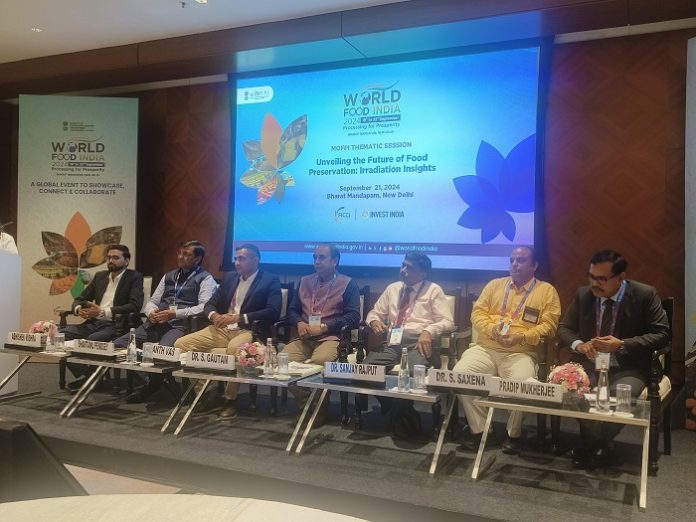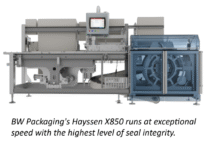
Irradiation is the application of radiation methods such as such as X-rays or gamma rays for therapeutic purposes or for sterilization to ensure food safety. At World Food India in New Delhi, one of the sessions talked about ‘Unveiling the future of food preservation – Irradiation insights’. Pradip Mukherjee, chief executive of the Board of Radiation and Isotope Technologies (BRIT) was the moderator.
Dr S Gautam, head, food technology division, Bhabha Atomic Research Centre (BARC) gave an insightful presentation on the innovative applications of irradiation in food security and safety. He said there are many challenges for food security in India, including conserving land and water use, achieving high yield and productivity, protecting plant and animal health, adapting to climate change, balancing food and fuel needs and higher costs of food and agricultural inputs.
The Bhabha Atomic Research Centre under the department of atomic energy (DAE) had improved 62 varieties in 12 different crops, which included 28 in oilseeds, 24 in pulses and 10 in cereal, millet and fiber crops and these have been made available to farmers for cultivation, he said.
Gamma rays from Cobalt-60 or Cesium-137, X-rays at or below an energy level of 7.5 MeV and electrons at or below an energy level of 10 MeV are approved radiation sources for food irradiation in India, he said, adding the technology finds usage in insect control in cereals and pulses, microbial decontamination of spices, RTE food for calamities, phytosanitary (relating to the health of plants, or measures taken to control plant diseases) treatment of fruits and vegetables for export and shelf life extension, sprout inhibition in onion and potato, and safety and shelf-life extension of meat and fish.
Gautam informed the audience that there are a total of 28 food irradiation facilities in India, out of which five are government-owned while the remaining 23 are private. The government of India has announced financial support for setting up 50 multi-product food irradiation facilities in different parts of the country in the 2024-25 budget. He shared case studies of large-scale irradiation of potatoes for extended chemical-free preservation and radiation processing of mangoes to overcome the quarantine barrier of trade.
S Saxena, scientific officer at the food technology division of BARC gave another presentation on the effects on the nutritional integrity of any food subjected to radiation processing. While low dose application is less than 1 kGy, medium dose application has a 1-10 kGy limit while high dose application is greater than 1 kGy, he explained. He shared case studies of chemical-free extended preservation of potato, secondary products from strawberry fruit for extended preservation and value addition, and microbial decontamination and value addition of herbal powders. He also shared documented reports on the safety of irradiated foods.
Ananth Vas, director, Symec Engineers (India), spoke on the development of custom-designed equipment and systems for nuclear, biotech, pharmaceutical, chemical and food processing industries. Currently, all existing irradiation facilities are designed to process food and other products in packed condition, he said, adding this is not ideal for food grains as it requires multiple handling and transportation in different facilities to carry out all the post-harvest activities. He shared valuable insights on the development of systems for temperature-sensitive products such as frozen seafood.
Abhishek Mishra, director, Solas Irradiation Unit, Solas Industries shared a presentation on irradiation as a service: business models and opportunities while Shantanu Pendsey, chief general manager (ABU&GSS), State Bank of India, spoke about how banks can provide financial support to organizations planning to set up irradiation facilities.
IndiFoodBev — authentic, impactful and influential
An English-language food and beverage processing and packaging industry B2B platform in print and web, IndiFoodBev is in its third year of publication. It is said that the Indian food and beverage industries represent approximately US$ 900 billion in revenues which implies more than 20% of the country’s GDP. Eliminating the wastage on the farmside can help to deliver more protein to a higher number of the population apart from generating sizable exports. The savings in soil, seeds, water, fertilizer, energy and ultimately food and nutrition could be the most immense contribution that country is poised to make to the moderation of climate change.
To improve your marketing and grow sales to the food and beverage processing and packaging industry, talk to us. Our research and consulting company IppStar [www.ippstar.org] can assess your potential and addressable markets in light of the competition. We can discuss marketing, communication, and sales strategies for market entry and growth.
Suppliers and service providers with a strategy and budget for targeted marketing can discuss using our hybrid print, web, video, and social media channels to create brand recognition linked to market relevance. Our technical writers are ready to meet you and your customers for content.
The second largest producer of fruit and vegetables in the world is continuously expanding processing capacities and delivery systems with appropriate innovative technologies. We cover product and consumer trends, nutrition, processing, research, equipment and packaging from farm to thali. Get our 2025 media kit and recalibrate your role in this dynamic market. Enhance your visibility and relevance to existing markets and turn potential customers into conversations. Ask for a sample copy of our bi-monthly in print or our weekly IndiFoodBev eZine each Wednesday.
For editorial info@ippgroup.in — for advertisement ads1@ippgroup.in and for subscriptions subscription@ippgroup.in
Naresh Khanna – 10 February 2025
Subscribe Now











